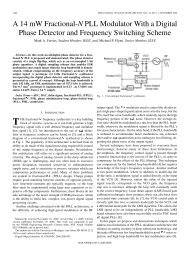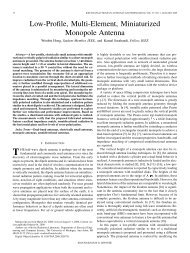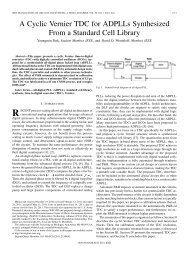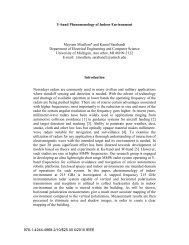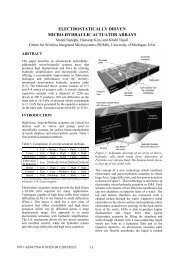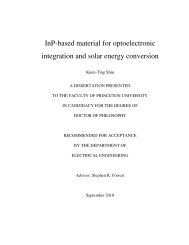Subwavelength Radio Repeater System Utilizing ... - IEEE Xplore
Subwavelength Radio Repeater System Utilizing ... - IEEE Xplore
Subwavelength Radio Repeater System Utilizing ... - IEEE Xplore
- No tags were found...
Create successful ePaper yourself
Turn your PDF publications into a flip-book with our unique Google optimized e-Paper software.
2690 <strong>IEEE</strong> TRANSACTIONS ON ANTENNAS AND PROPAGATION, VOL. 59, NO. 7, JULY 2011isolator is shown to suppress the mutual coupling, improvingthe transmission coefficient from 18 dB to 42dB. The dimensions of the TX/RX antennas and a unitcell of the isolator areand, respectively. Theoverall dimensions of the proposed radio repeater are, which correspondsto. The proposed radio repeatersystem has been simulated and verified experimentally. Theprototype of the design has been fabricated using printed circuittechnology, which serves to reduce fabrication complexity andallows for easy commercial production at a large scale.Such a radio repeater system can mitigate the adverse effectsof obstacles in radio connectivity for ad-hoc networks in complexenvironments.REFERENCES[1] S. K. Park, P.-J. Song, and G. S. Bae, “Joint optimization of radio repeaterlocation and linking in WLL systems with 2.3 GHz frequencyband,” in Proc. <strong>IEEE</strong> Int. Conf. on Communications, 1999, vol. 3, pp.1617–1621.[2] P. Slobodzian, “Estimation of the repeater gain required for a wirelesslink,” in Proc. 15th Int. Conf. on Microwaves, Radar and WirelessCommunications, May 2004, vol. 2, pp. 656–659.[3] J. Borkowski, J. Niemela, T. Isotalo, P. Lahdekorpi, and J. Lempiainen,“Utilization of an indoor DAS for repeater deployment in WCDMA,”in Proc. <strong>IEEE</strong> 63rd Vehicular Technology Conf., May 2006, vol. 3, pp.1112–1116.[4] A. H. Naemat, A. Tee, A. S. M. Marzuki, B. Mohmd, K. Khalil, and A.R. A. Rahim, “Achieving optimum in-building coverage of 3 G networkin Malaysia,” in Proc. <strong>IEEE</strong> Int. RF and Microwave Conf., Sep. 2006,pp. 343–346.[5] B. W. Lovinggood, M. D. Judd, and W. P. Kuiper, “Integrated <strong>Repeater</strong>,”U.S. Patent 6,934,511 B1, 2005.[6] D. L. Runyon, S. B. Thompson, J. W. Maxwell, and D. L. M. SR.,“Wireless <strong>Repeater</strong> With Feedback Suppression Features,” U.S. Patent2006/0 205 343 A1, 2006.[7] T. W. Ban, B. Y. Cho, W. Choi, and H.-S. Cho, “On the capacity of aDS/CDMA system with automatic on-off switching repeaters,” in Proc.<strong>IEEE</strong> Int. Conf. on Communications, 2001, vol. 3, pp. 780–784.[8] M. Lee, B. Keum, Y. Son, J.-W. Kim, and H. S. Lee, “A new low-complexinterference cancellation scheme for WCDMA indoor repeaters,”in Proc. <strong>IEEE</strong> Region 8 Int. Conf. on Computational Technologies inElectrical and Electronics Engineering, Jul. 2008, pp. 457–462.[9] D. Liao and K. Sarabandi, “Terminal-to-terminal hybrid full-wave simulationof low-profile, electrically-small, near-ground antennas,” <strong>IEEE</strong>Trans. Antennas Propag., vol. 56, no. 3, pp. 806–814, Mar. 2008.[10] W. Hong and K. Sarabandi, “Low-profile, multi-element, miniaturizedmonopole antenna,” <strong>IEEE</strong> Trans. Antennas Propag., vol. 57, no. 1, pp.72–80, Jan. 2009.[11] D. Sievenpiper, L. Zhang, R. Broas, N. Alexopolous, and E.Yablonovitch, “High-impedance electromagnetic surfaces with aforbidden frequency band,” <strong>IEEE</strong> Microw. Theory Tech., vol. 47, no.11, pp. 2059–2074, Nov. 1999.[12] F. Yang and Y. Rahmat-Samii, “Microstrip antennas integrated withelectromagnetic band-gap (EBG) structures: A low mutual couplingdesign for array applications,” <strong>IEEE</strong> Trans. Antennas Propag., vol. 51,no. 10, pp. 2936–2946, Oct. 2003.[13] K. Buell, H. Mosallaei, and K. Sarabandi, “Metamaterial insulator enabledsuperdirective array,” <strong>IEEE</strong> Trans. Antennas Propag., vol. 55, no.4, pp. 1074–1085, April 2007.[14] H. Mosallaei and K. Sarabandi, “Design and modeling of patch antennaprinted on magneto-dielectric embedded-circuit metasubstrate,” <strong>IEEE</strong>Trans. Antennas Propag., vol. 55, no. 1, pp. 45–52, Jan. 2007.[15] R. Igreja and C. J. Dias, “Analytical evaluation of the interdigital electrodescapacitance for a multi-layered structure,” Sensors Actuat. A:Phys., vol. 112, no. 2–3, pp. 291–301, 2004.Kamal Sarabandi (S’87–M’90–SM’92–F’00) receivedthe B.S. degree in electrical engineering fromthe Sharif University of Technology, Tehran, Iran,in 1980, the M.S. degree in electrical engineeringin 1986, and the M.S. degree in mathematics andthe Ph.D. degree in electrical engineering from TheUniversity of Michigan at Ann Arbor, in 1989.He is currently the Director of the Radiation Laboratoryand the Rufus S. Teesdale Professor of Engineeringin the Department of Electrical Engineeringand Computer Science, The University of Michiganat Ann Arbor. His research areas of interest include microwave and millimeterwaveradar remote sensing, metamaterials, electromagnetic wave propagation,and antenna miniaturization. He possesses 25 years of experience with wavepropagation in random media, communication channel modeling, microwavesensors, and radar systems and leads a large research group including two researchscientists, 14 Ph.D. students. He has graduated 36 Ph.D. and supervisednumerous post-doctoral students. He has served as the Principal Investigator onmany projects sponsored by the National Aeronautics and Space Administration(NASA), Jet Propulsion Laboratory (JPL), Army Research Office (ARO), Officeof Naval Research (ONR), Army Research Laboratory (ARL), National ScienceFoundation (NSF), Defense Advanced Research Projects Agency (DARPA),and a large number of industries. Currently he is leading the Center for Microelectronicsand Sensors funded by the Army Research Laboratory underthe Micro-Autonomous <strong>System</strong>s and Technology (MAST) Collaborative TechnologyAlliance (CTA) program. He has published many book chapters andmore than 185 papers in refereed journals on miniaturized and on-chip antennas,metamaterials, electromagnetic scattering, wireless channel modeling, randommedia modeling, microwave measurement techniques, radar calibration, inversescattering problems, and microwave sensors. He has also had more than 442 papersand invited presentations in many national and international conferencesand symposia on similar subjects.Dr. Sarabandi is a member of Commissions F and D of URSI. He wasthe recipient of the Henry Russel Award from the Regent of The Universityof Michigan. In 1999, he received a GAAC Distinguished Lecturer Awardfrom the German Federal Ministry for Education, Science, and Technology.He was also a recipient of the 1996 EECS Department Teaching ExcellenceAward and a 2004 College of Engineering Research Excellence Award. In2005 he received the <strong>IEEE</strong> GRSS Distinguished Achievement Award and theUniversity of Michigan Faculty Recognition Award. He also received the bestpaper Award at the 2006 Army Science Conference. In 2008 he was awardeda Humboldt Research Award from The Alexander von Humboldt Foundationof Germany and received the best paper award at the <strong>IEEE</strong> Geoscience andRemote Sensing Symposium. He was also awarded the 2010 DistinguishedFaculty Achievement Award from the University of Michigan. The <strong>IEEE</strong> Boardof Directors announced him as the recipient of the 2011 <strong>IEEE</strong> Judith A. Resnikmedal. He served as a member of NASA Advisory Council appointed by theNASA Administrator for two consecutive terms from 2006–2010. He is servingas a Vice President of the <strong>IEEE</strong> Geoscience and Remote Sensing Society(GRSS) and is a member of the Editorial Board of the PROCEEDINGS OF THE<strong>IEEE</strong>. He was an Associate Editor of the <strong>IEEE</strong> TRANSACTIONS ON ANTENNASAND PROPAGATION and the <strong>IEEE</strong> SENSORS JOURNAL. In the past several years,joint papers presented by his students at a number of international symposia(<strong>IEEE</strong> APS’95,’97,’00,’01,’03,’05,’06,’07; <strong>IEEE</strong> IGARSS’99,’02,’07; <strong>IEEE</strong>IMS’01, USNC URSI’04,’05,’06,’10,’11 AMTA ’06, URSI GA 2008) havereceived best paper awards.Young Jun Song (S’07) received the B.S. degree inelectrical engineering (summa cum laude) from theSeoul National University, Seoul, Korea, in 2006, andthe M.S. degree in electrical engineering from TheUniversity of Michigan at Ann Arbor, in 2009, wherehe is currently working toward the Ph.D. degree.



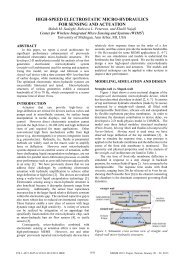
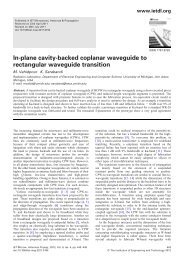
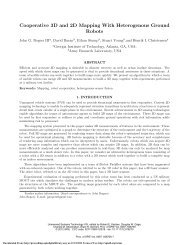
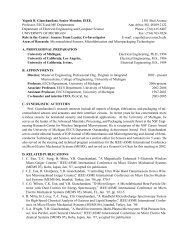
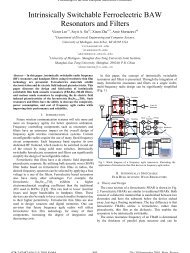
![[Sample B: Approval/Signature Sheet]](https://img.yumpu.com/34084789/1/190x245/sample-b-approval-signature-sheet.jpg?quality=85)
